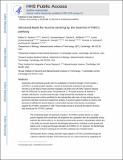Structural basis for leucine sensing by the Sestrin2-mTORC1 pathway
Author(s)
Saxton, Robert Andrew; Wolfson, Rachel Laura; Chantranupong, Lynne; Wang, Tim; Schwartz, Thomas; Sabatini, David; Knockenhauer, Kevin Edward; Pacold, Michael Edward; ... Show more Show less
DownloadSabatini_Structural basis.pdf (828.3Kb)
PUBLISHER_POLICY
Publisher Policy
Article is made available in accordance with the publisher's policy and may be subject to US copyright law. Please refer to the publisher's site for terms of use.
Terms of use
Metadata
Show full item recordAbstract
Eukaryotic cells coordinate growth with the availability of nutrients through the mechanistic target of rapamycin complex 1 (mTORC1), a master growth regulator. Leucine is of particular importance and activates mTORC1 via the Rag guanosine triphosphatases and their regulators GATOR1 and GATOR2. Sestrin2 interacts with GATOR2 and is a leucine sensor. Here we present the 2.7 angstrom crystal structure of Sestrin2 in complex with leucine. Leucine binds through a single pocket that coordinates its charged functional groups and confers specificity for the hydrophobic side chain. A loop encloses leucine and forms a lid-latch mechanism required for binding. A structure-guided mutation in Sestrin2 that decreases its affinity for leucine leads to a concomitant increase in the leucine concentration required for mTORC1 activation in cells. These results provide a structural mechanism of amino acid sensing by the mTORC1 pathway.
Date issued
2016-11Department
Massachusetts Institute of Technology. Department of Biology; Whitehead Institute for Biomedical ResearchJournal
Science
Publisher
American Association for the Advancement of Science (AAAS)
Citation
Saxton, R. A., K. E. Knockenhauer, R. L. Wolfson, L. Chantranupong, M. E. Pacold, T. Wang, T. U. Schwartz, and D. M. Sabatini. “Structural Basis for Leucine Sensing by the Sestrin2-mTORC1 Pathway.” Science 351, no. 6268 (November 19, 2015): 53–58. © 2016 American Association for the Advancement of Science
Version: Author's final manuscript
ISSN
0036-8075
1095-9203